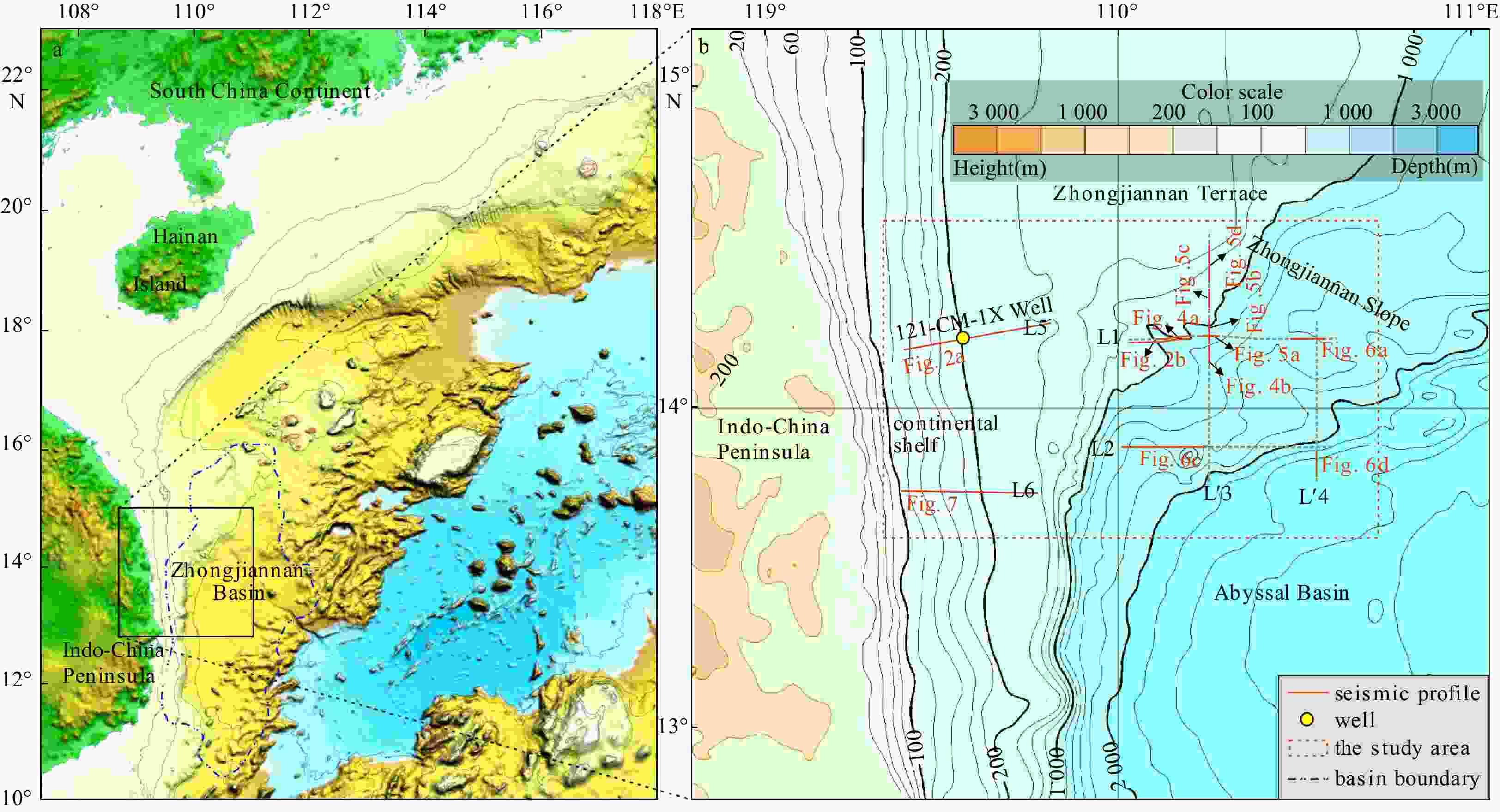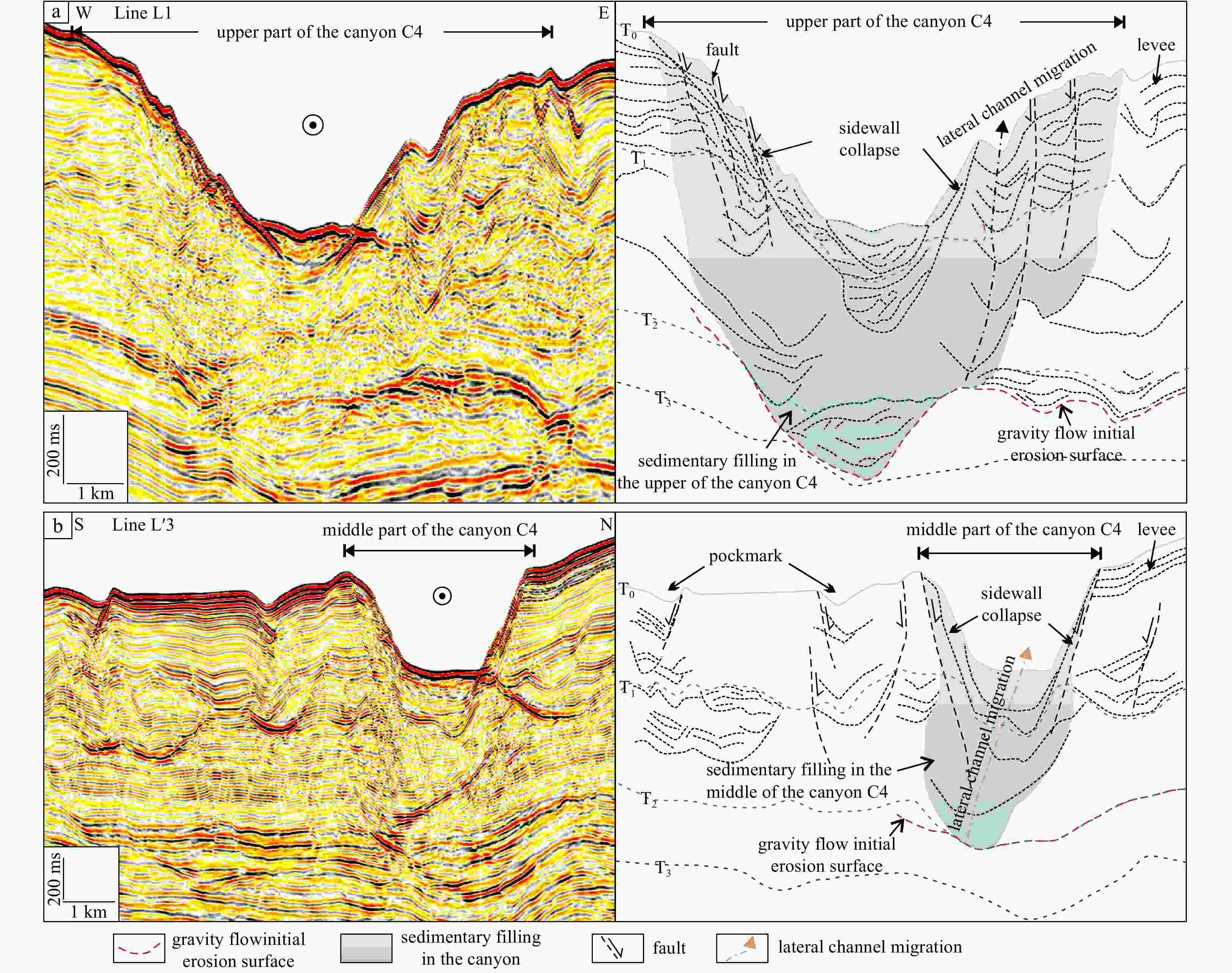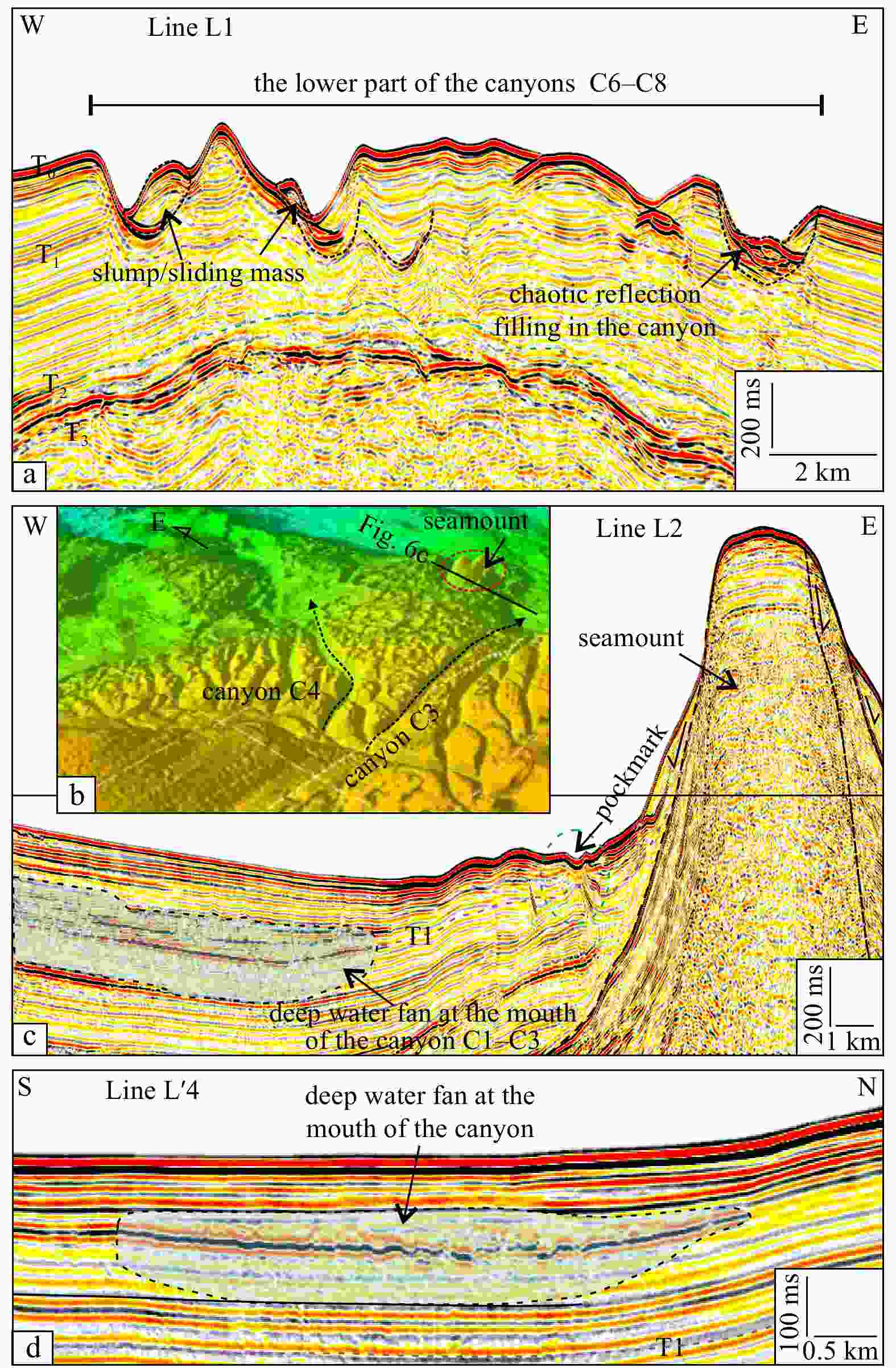Sedimentary evolution and control factors of the Rizhao Canyons in the Zhongjiannan Basin, western South China Sea
-
Abstract: Submarine canyon is an important channel for long-distance sediment transport, and an important part of deep-water sedimentary system. The large-scale Rizhao Canyons have been discovered for the first time in 2015 in the continental slope area of the western South China Sea. Based on the interpretation and analysis of multi-beam bathymetry and two-dimensional multi-channel seismic data, the geology of the canyons has however not been studied yet. In this paper, the morphology and distribution characteristics of the canyon are carefully described, the sedimentary filling structure and its evolution process of the canyon are analyzed, and then its controlling factors are discussed. The results show that Rizhao Canyons group is a large slope restricted canyon group composed of one east−west west main and nine branch canyons extending to the south. The canyon was formed from the late Miocene to the Quaternary. The east−west main canyon is located in the transition zone between the northern terrace and the southern Zhongjiannan Slope, and it is mainly formed by the scouring and erosion of the material source from the west, approximately along the slope direction. Its development and evolution is mainly controlled by sediment supply and topographic conditions, the development of 9 branch canyons is mainly controlled by gravity flow and collapse from the east−west main canyon. This understanding result is a supplement to the study of “source-channel–sink” sedimentary system in the west of the South China Sea, and has important guiding significance for the study of marine geological hazards.
-
Key words:
- canyon /
- geomorphology /
- sedimentary evolution /
- control factors /
- Zhongjiannan Basin /
- western South China Sea
-
Figure 1. Geographical location of Zhongjiannan Basin study area (a) and bathymetric contour map of the study area and its periphery (b) (Yang et al., 2015).
Figure 2. Sequence stratigraphic division in the seismic line L5 passing through drilling 121-CM-1X Well, according to Fyhn et al. (2009) (a) and sequence stratigraphic division in the seismic survey line L1 in the study area (b). According to the calibration of 121-CM-1X drilling data, Sequence A is Quaternary, Sequence B is Pliocene, and Sequence C is Pliocene. The locations of the seismic line L5 and L1 are marked on Fig. 1b.
Figure 3. Topographic slope map of Rizhao submarine canyon (a) and sketch of canyon shape (b) (the location is shown in Fig. 1b).
Figure 5. Seismic profile and interpretation of the canyons C5, C6, and main canyon, middle part of C5 on seismic profile L1 (a), middle part of C5 on seismic profile L′3 (b), upper part of C6 on seismic profile L′3 (c) and the main canyon on seismic profile L′3 (d) (profile location is shown in Figs 1b and 2).
Figure 6. Seismic line L1 across the lower section of canyons C6–C8 (a), local topographic map of canyons area (b), seismic survey line L2 across the downstream of canyons C1–C3 and the mouth (c) and seismic line L′4 across the downstream of the canyons and the mouth (d) (see Fig. 1b for profile location).
Figure 7. The interpretation of seismic profile L6 across the continental shelf and the upper slope in the west of the study areas (modified from Fyhn et al. (2009); location of lines is shown in Fig. 1b).
Table 1. Genetic classification of main canyons in the South China Sea
Classification basis Major characteristics Typical example Geomorphic morphological characteristics Large-scale canyon dominated by a main canyon with less developed branch canyons Taitung Canyon, Taiwan Canyon, Dongsha Canyon, Zhujiang River Estuary Canyon, Penxi Canyos Composed of several small and short canyons Penghu Canyons, Yitong Canyons, Xishabei Canyons It is composed of the main canyon and multiple branch canyons Rizhao Canyons Development location, genesis The continental erosion canyon is generally related to onshore rivers or deltas Taiwan Shoal submarine canyon, Zhujiang River Estuary Canyon, Dongsha Canyon The head is developed only in the continental slope area, usually related to the turbidity current events, gravity-flow transport, traceable slump, and bottom current Shenhu Canyons,
Rizhao CanyonsTable 2. Typical seismic facies analysis and corresponding sedimentary facies interpretation of canyon system
Serial No. Line No. Seismic profile Seismic reflection characteristics Sedimentary facies Origin a L1 low continuous reflection and chaotic reflection gravity flow deposit gravity flow b L1 parallel reflection channel-fill facies turbidity current c L1 medium-high continuous and two-way onlap reflection d L' 3 medium continuous and two-way onlap reflection e L' 3 medium-low continuous reflection f L' 3 medium-high continuous onlap reflection channel migration gravity flow g L1 medium continuous reflection slump mass gravity flow h L1 medium continuous reflection in the upper part,
chaotic reflection in the lower partslump mass, sliding mass chaotic reflection filling in the channel channel-fill facies turbidity current i L' 4 local strong amplitude continuous-low
continuous reflectiondeep water fan -
Antobreh A A, Krastel S. 2006. Morphology, seismic characteristics and development of Cap Timiris Canyon, offshore Mauritania: A newly discovered canyon preserved-off a major arid climatic region. Marine and Petroleum Geology, 23(1): 37–59. doi: 10.1016/j.marpetgeo.2005.06.003 Babonneau N, Savoye B, Cremer M, et al. 2002. Morphology and architecture of the present canyon and channel system of the Zaire deep-sea fan. Marine and Petroleum Geology, 19(4): 445–467. doi: 10.1016/S0264-8172(02)00009-0 Chen Hui. 2014. Characteristics and evolution of deep-water sedimentary systems on the northwestern margin slopes of the Northwest Sub-Basin, South China Sea (in Chinese) [dissertation]. Wuhan: China University of Geosciences (Wuhan) Chen Hui, Xie Xinong, Mao Kainan, et al. 2020. Depositional characteristics and formation mechanisms of deep-water canyon systems along the Northern South China Sea margin. Journal of Earth Science, 31(4): 808–819. doi: 10.1007/s12583-020-1284-z Davies R J, Thatcher K E, Mathias S A, et al. 2012. Deepwater canyons: an escape route for methane sealed by methane hydrate. Earth and Planetary Science Letters, 323–324: 72–78 Ding Weiwei, Li Jiabiao, Li Jun, et al. 2013. Formation process and controlling factors of the Pearl River Canyon in the South China Sea. Journal of Tropical Oceanography (in Chinese), 32(6): 63–72. doi: 10.3969/j.issn.1009-5470.2013.06.010 Fyhn M B W, Boldreel L O, Nielsen L H. 2009. Geological development of the Central and South Vietnamese margin: Implications for the establishment of the South China Sea, Indochinese escape tectonics and Cenozoic volcanism. Tectonophysics, 478(3–4): 184–214. doi: 10.1016/j.tecto.2009.08.002 Gao Hongfang, Chen Ling. 2006. An analysis of structural framework and formation mechanism of Zhongjiannan Basin in the west of South China Sea. Oil & Gas Geology (in Chinese), 27(4): 512–516 Gingele F X, De Deckker P, Hillenbrand C D. 2004. Late Quaternary terrigenous sediments from the Murray Canyons area, offshore South Australia and their implications for sea level change, palaeoclimate and palaeodrainage of the Murray-Darling Basin. Marine Geology, 212(1–4): 183–197. doi: 10.1016/j.margeo.2004.09.001 Harris P T, Whiteway T. 2011. Global distribution of large submarine canyons: Geomorphic differences between active and passive continental margins. Marine Geology, 285(1–4): 69–86. doi: 10.1016/j.margeo.2011.05.008 Laursen J, Normark W R. 2002. Late Quaternary evolution of the San Antonio Submarine Canyon in the central Chile forearc (~33°S). Marine Geology, 188(3–4): 365–390. doi: 10.1016/S0025-3227(02)00421-8 Li Xishuang, Liu Lejun, Li Jiagang, et al. 2015. Mass movements in small canyons in the northeast of Baiyun deepwater area, north of the South China Sea. Acta Oceanologica Sinica, 34(8): 35–42. doi: 10.1007/s13131-015-0702-Z Liu Jie, Su Ming, Qiao Shaohua, et al. 2016. Forming mechanism of the slope-confined submarine canyons in the Baiyun Sag, Pearl River Mouth Basin. Acta Sedimentologica Sinica (in Chinese), 34(5): 940–950 Lofi J, Gorini C, Berné S, et al. 2005. Erosional processes and paleo-environmental changes in the Western Gulf of Lions (SW France) during the Messinian Salinity Crisis. Marine Geology, 217(1–2): 1–30. doi: 10.1016/j.margeo.2005.02.014 Luo Weidong, Zhou Jiao, Li Xuejie, et al. 2018. Morphology and structure and evolution of West Basin Canyon, South China Sea. Earth Science, 43(6): 2172–2183 McDonnell A, Loucks R G, Galloway W E. 2008. Paleocene to Eocene deep-water slope canyons, western Gulf of Mexico: further insights for the provenance of deep-water offshore Wilcox Group plays. AAPG Bulletin, 92(9): 1169–1189. doi: 10.1306/05150808014 McHugh C M G, Damuth J E, Mountain G S. 2002. Cenozoic mass-transport facies and their correlation with relative sea-level change, New Jersey continental margin. Marine Geology, 184(3–4): 295–334. doi: 10.1016/S0025-3227(01)00240-7 Micallef A, Ribó M, Canals M, et al. 2014. Space-for-time substitution and the evolution of a submarine canyon-channel system in a passive progradational margin. Geomorphology, 221: 34–50. doi: 10.1016/j.geomorph.2014.06.008 Nie Xin, Luo Weidong, Zhou Jiao. 2017. Depositional characteristics of the Penghu submarine canyon in the northeastern South China Sea. Marine Geology Frontiers (in Chinese), 33(8): 18–23. doi: 10.16058/j.1009-2722.2019.08003 Popescu I, Lericolais G, Panin N, et al. 2004. The Danube submarine canyon (Black Sea): Morphology and sedimentary processes. Marine Geology, 206(1–4): 249–265. doi: 10.1016/j.margeo.2004.03.003 Sanchez C M, Fulthorpe C S, Steel R J. 2012. Miocene shelf-edge deltas and their impact on deepwater slope progradation and morphology, Northwest Shelf of Australia. Basin Research, 24(6): 683–698. doi: 10.1111/j.1365-2117.2012.00545.x Shang Zhilei, Xie Xinong, Li Xushen, et al. 2015. Difference in full-filled time and its controlling factors in the Central Canyon of the Qiongdongnan Basin. Acta Oceanologica Sinica, 34(10): 81–89. doi: 10.1007/s13131-015-0717-5 Shepard F P. 1981. Submarine canyons: Multiple causes and long-time persistence. AAPG Bulletin, 65(6): 1062–1077 Su Ming, Zhang Cheng, Xie Xinong, et al. 2014. Controlling factors on the submarine canyon system: a case study of the Central Canyon System in the Qiongdongnan Basin, northern South China Sea. Science China: Earth Sciences, 57(10): 2457–2468. doi: 10.1007/s11430-014-4878-4 Sun Meijing, Gao Hongfang, Li Xuejie, et al. 2020. Sedimentary evolution characteristics since late Miocene in the Huatung Basin. Haiyang Xuebao (in Chinese), 42(1): 154–162. doi: 10.3969/j.issn.0253−4193.2020.01.016 Sun Meijing, Yao Yongjian, Luo Weidong, et al. 2022. Sedimentary evolution characteristics and controlling factors of Zhongjiannan Canyons in northwestern South China Sea. Earth Science, 47(11): 4005–4019. doi: 10.3799/dqkx.2022.034 Wang Xingxing, Cai Feng, Sun Zhilei, et al. 2021. Sedimentary evolution and geological significance of the Dongsha submarine canyon in the northern South China Sea. Earth Science (in Chinese), 46(3): 1023–1037. doi: 10.3799/dqkx.2020.277 Wu Shiguo, Qin Yunshan. 2009. The research of deepwater depositional system in the northern South China Sea. Acta Sedimentologica Sinica (in Chinese), 27(5): 922–930 Wu Shiguo, Qin Zhiliang, Wang Dawei, et al. 2011. Seismic characteristics and triggering mechanism analysis of mass transport deposits in the northern continental slope of the South China Sea. Chinese Journal of Geophysics (in Chinese), 54(12): 3184–3195. doi: 10.3969/j.issn.0001-5733.1011.12.018 Xie Xinong, Chen Zhihong, Sun Zhipeng, et al. 2012. Depositional architecture characteristics of deepwater depositional systems on the continental margins of northwestern South China Sea. Earth Science—Journal of China University of Geosciences (in Chinese), 37(4): 627–634. doi: 10.3799/dqkx.2012.072 Xu Shang, Wang Yingmin, Peng Xuechao, et al. 2014. Origin of Taiwan Canyon and its effects on deepwater sediment. Science China: Earth Sciences, 57(11): 2769–2780. doi: 10.1007/s11430-014-4942-0 Yang Shengxiong, Qiu Yan, Zhu Benduo, et al. 2015. Geological and Geophysical Maps of the South China Sea (1: 2000000) (in Chinese). Tianjin: China Navigation Book Publishing House Yao Yongjian, Lü Caili, Wang Lijie, et al. 2018. Tectonic evolution and genetic mechanism of the Wan’an Basin, southern South China Sea. Haiyang Xuebao (in Chinese), 40(5): 62–74. doi: 10.3969/j.issn.0253-4193.2018.05.006 Yi Shantang, Hu Xiaosan, Luo Zongjie, et al. 2020. Geomorphological characteristics and controlling factors of the Yitong Canyon group on the northern slope of the South China Sea. Marine Geology Frontiers (in Chinese), 36(4): 18–26. doi: 10.16058/j.1009-2722.2019.185 Yin Shaoru, Wang Liaoliang, Guo Yiqun, et al. 2015. Morphology, sedimentary characteristics, and origin of the Dongsha submarine canyon in the northeastern continental slope of the South China Sea. Science China: Earth Sciences, 58(6): 971–985. doi: 10.1007/s11430-014-5044-8 Yu Kaiqi, Miramontes E, Alves T M, et al. 2021. Incision of submarine channels over pockmark trains in the South China Sea. Geophysical Research Letters, 48(24): e2021GL092861. doi: 10.1029/2021GL092861 Yuan Shengqiang, Wu Shiguo, Yao Genshun. 2010. The controlling factors analysis of Qiongdongnan slope deepwater channels and its significance to the hydrocarbon exploration. Marine Geology and Quaternary Geology (in Chinese), 30(2): 61–66. doi: 10.3724/SP.J.2010.02061 Zhong Guangjian, Gao Hongfang. 2005. Sequence characteristics of Cenozoic stratigraphy in Zhongjiannan Basin, South China Sea. Geotectonica et Metallogenia (in Chinese), 29(3): 403–409. doi: 10.16539/j.ddgzyckx.2005.03.017 -





 下载:
下载:










